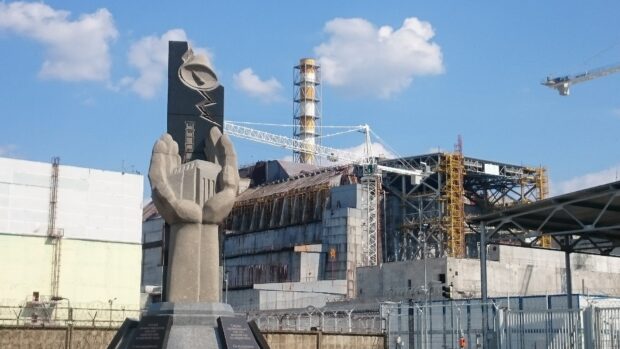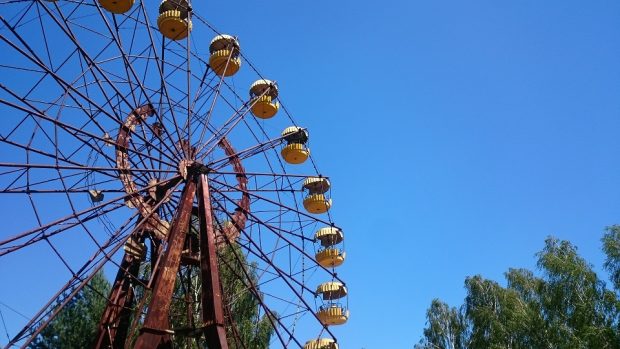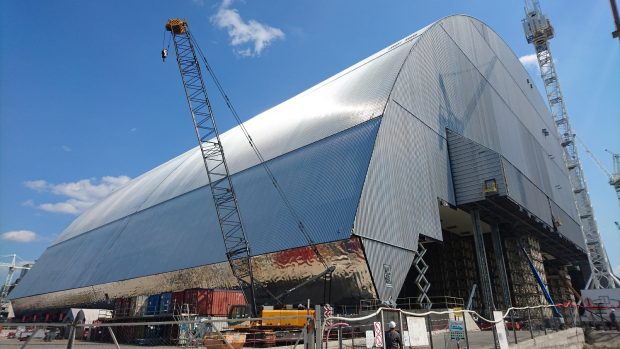Chernobyl drama sparks huge interest in nuclear, so let's talk about it
10 Jun 2019 03:09 PM
Blog posted by: Claire Corkhill, 7 June 2019 – Categories: International activities, Research and development, Supply Chain, Waste management.
The success of Sky Atlantic's Chernobyl mini-series is clear evidence of the growing public appetite to understand more about nuclear, says Dr Claire Corkhill.
Critically acclaimed as “one of the finest TV dramas ever made”, the series brought the human and political story of the world’s worst nuclear disaster vividly to life.

A stone monument pays tribute to the builders of Reactor 4's original sarcophagus, shown here just before the new arch was moved into place
Claire, who’s based at The University of Sheffield's world-leading nuclear waste research team, the Immobilisation Science Laboratory, is one of the leads for a research programme (TRANSCEND) involving 11 universities that’s supported by the NDA, Engineering and Physical Research Council (EPSRC)together with industry.
With each episode aired, her avalanche of tweets about the science and physics behind nuclear power added an extra dimension to events unfolding on screen.
The clean-up at Chernobyl has been under way for 33 years and will continue for many more. The TV series has really sparked discussion about the nuclear industry. I think this is a fantastic opportunity to explain what we’re doing here in the UK and, although people rarely actually think about nuclear, I’ve found they’re fascinated once you start talking – they realise our own nuclear legacy is a long-term challenge that needs solving and are amazingly supportive.
We’ve visited science fairs and other festivals, such as glass-making events, to talk about the pioneering science we're involved with, for example, how we’re trying to solidify radioactive waste in glass or ceramics.”
Back to Chernobyl though: Dealing with the aftermath of Unit 4’s meltdown back in 1986 still costs the Ukraine 7% of its annual GDP, and has involved teams from across the globe. I’ve visited the site several times and it’s far busier than I’d been expecting, with activities going on everywhere. There’s a sense of calm and focus to the work, more or less like any operational nuclear site over here.

A rusting ferris wheel in the city of Pripyat, abandoned 33 years ago
I was particularly moved by the memorial to Valery Khodemchuk, the first victim from the steam explosion, which was installed between Units 3 and 4. The high radiation readings at that location were another powerful reminder of the events that happened on the site.
The international efforts in Ukraine include a number of contractors who have worked delivering the NDA’s own clean-up mission:
- global nuclear engineering, project management and service provider Nuvia has supplied radiation monitoring and characterisation services, such as fire protection systems. Their parent company VINCI were a partner in the ‘design and build consortia’ for the Confinement Arch – the largest moving structure ever built - now enclosing the damaged Unit 4 reactor. Nuvia is active on a number of NDA sites and won an NDA supply chain innovation award for work on a self-climbing platform at Sellafield
- materials technology specialist Lucideon, who carried out testing out on the arch at their Stoke-on-Trent HQ over 2 years to ensure the cladding could withstand the Ukrainian climate and contain radiation for a century. Lucideon, along with Sellafield, won a Nuclear Institute award in 2015 for an innovative encapsulation process funded by Innovate UK and the NDA, and is currently undertaking a programme of high-temperature tensile testing for INS, and providing ongoing material characterisation and consultancy for Sellafield Ltd
- PaR Systems, a specialist in in automated handling systems, installed remotely operated cranes underneath the arch, together with a lightweight extendable platform that can deploy a range of robotic tools, which will be the main system used to remediate the reactor. The US company, which supplies systems to Sellafield, opened a new Remote Handling Centre of Excellence in Cumbria last year
PaR Systems and Nuvia are both involved in the £8.5 million Integrated Innovation in Nuclear Decommissioning competition being run by the NDA and Innovate UK.

The new safe confinement arch over Reactor 4
Chernobyl’s massive protective cover was slid in to place on rails, covering the original shielding that was hastily constructed in the immediate aftermath of the accident. Under the protection of the Confinement Arch, the existing shelter and the damaged reactor will ultimately be dismantled.
Meanwhile, before joining the NDA, waste specialist Matt Buckley also worked on the clean-up. With colleagues in Kiev and France, he supported development of the internal arch buildings layout and ran option studies to refine detailed aspects of the arch design itself. He also worked on an earlier European Commission collaborative study into remediation options for the contaminated sediments of the Chernobyl cooling pond.
Sheffield’s highly specialised Immobilisation Science Lab (ISL), where Claire is based, has been involved in a joint programme to understand how fuel debris retrieved from both Chernobyl and Fukushima is corroding, creating uranium-bearing radioactive dust – then how to deal with it.
Experts from the National Academy of Sciences of Ukraine have also spent time in Sheffield, looking at how to deal with the damaged fuel, and whether, for example, it could be heat-treated and immobilised in a glass or ceramic solid, or perhaps otherwise encapsulated, possibly reprocessed. The clean-up at both plants will carry on for many decades.
The NDA has recently signed a bilateral agreement with the State Agency of Ukraine on Exclusion Zone Management (SAUEZM) which is responsible for the decommissioning Chernobyl and land remediation in the exclusion zone. This is intended to lead to joint approaches on land remediation, stakeholder engagement and institutional control for long periods.
These initiatives support the Nuclear Sector Deal commitments to encourage international collaboration and the sharing of UK expertise, as well as research projects.
The significant timescales of clean-up in Ukraine and Japan apply equally to decommissioning work at NDA sites in the UK, where the £9.4 million NDA-backed TRANSCEND programme is focusing its 40-plus academic studies.
Launched last year, TRANSCEND received a £4.6 million grant from the EPSCRC topped up with support from NDA, Sellafield Ltd, RWM, NNL, AWE, Cavendish Nuclear, LLWR Ltd and TÜV SÜD Nuclear Technologies. Led by the University of Leeds and involving 10 other universities, TRANSCEND continues the work of two earlier four-year programmes DIAMOND and DISTINCTIVE.
Claire and fellow academic Dr Joe Hriljac, of the University of Birmingham, are co-leading projects grouped under the Integrated Waste Management theme. The work includes:
- Developing new ion exchange materials for Sellafield that can be renewed or re-used. Ion exchange processes are used to bind or separate contaminated waste products.
- Investigating the behaviour of radioactive sludge from Magnox spent fuel ponds, to support retrieval and treatment options.
- Understanding how sludge and slurry mixtures flow through pipework as they are transferred between facilities, in order to prevent blockages or sediment build-up.
- Investigating how glass chemistry can be used to maximise solidification of wider types of waste, and minimise any radioactive volatility.
“These are among the hugely important topics that will contribute towards understanding the best options for cleaning up and decommissioning NDA sites. We’ll be retrieving and treating radioactive waste for many more years, so it’s vital we develop new technologies and new skills for the next generation of experts,” Claire added.
Follow Dr Claire Cockhill on Twitter
Find out more about radiation and radioactive waste
You may also be interested in:
Turning the corner to exciting times
Latest views from people interested in NDA and UK nuclear decommissioning